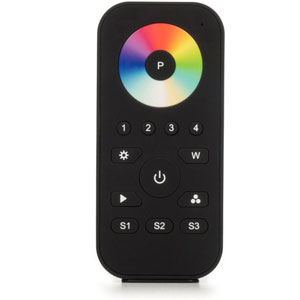LIGHT DIMMERS & CONTROLLERS

LED controllers, also called LED light controller, are the necessary parts to achieve remote control the lighting effects for LED strip and LED lights, including adjust brightness level, select color, and switch color-changing modes. We sell a large selection of LED controllers, including RF, Bluetooth, WiFi, multi zone LED strip light controller, and DMX LED controller. LED controllers also vary due to the different light fixtures controlled. For example, LED strip controllers have tunable white, RGB, and RGBW controller. Their performance and installation are discussed in detail below, helping you choose a right LED light controller.
Shop by Light Controller Series
Wired LED controllers and wireless LED controllers
1-1. Wired LED controllers. Wired LED controller is also called inline LED controller. Wired controllers are connected through hardwires and are placed between LED strip light and power supply. To adjust lighting effects, you need go to the place where the controller is located.
1-2. Wireless LED controller. The remote sender sends out wireless signal to receiver, and receiver controls the LED strips connected to it, such as color selection and tuning, color change, and brightness adjustment etc. The receiver is also placed between LED strip and power supply. Every controller has the function for turning on and off the lights. According to different types of wireless signal, wireless controllers are categorized as following:
- IR LED controller. IR controller requires line of sight to work, meaning the remote must see the receiver because the signal cannot go through barrier. 24-key or 44-key IR controllers are the often seen ones of this kind.
- RF LED controller. RF LED controller is the very often used wireless controller that utilizes radio frequency signal. RF signal can go through walls. It has a medium control range.
- WiFi LED controller. WiFi LED controller utilizes WiFi signal to establish connection between the controller and signal sender such as mobile phone or iPad. WiFi controllers require a network such as internet or local network. They have the widest control range among the wireless controllers.
- Bluetooth LED controller. Bluetooth LED controllers transmit Bluetooth signal and can communicate directly with a mobile phone. This type of controller doesn't need a network to work. It is the only type of controller that works with cell phone for places without network.
LED strip lights with remote is the strip lighting that can be controlled remotely by using any wireless controllers and remotes. It has the advantage of wireless control that the remote can be placed anywhere. This is very convenient to users who don't like to get up and walk to walls for controllers.
1-3. PWM LED controller. PWM controller is the named from another perspective for controllers. PWM stands for Pulse Width Modulation, a method using digital signal to generate analog signal. The adjusting strip lights by controllers is realized via the analog signal created with PWM method. Analog signal is the final and direct signal that controls the LED strip lighting. Almost all controllers are, in this sense, PWM controller.
1-4. The picture below provides an intuitive understanding of IR, RF, WiFi, Bluetooth, DMX, and PWM.

LED controller signal illustration
It can be seen from the above picture that IR, RF, WiFi, Bluetooth, and DMX signals work before the controller, while PWM is after. IR, RF, WiFi, Bluetooth, and DMX are different types of signals that communicate to controller, while PWM is the way to create analog signals that leave controller and talk to LED strip lights. So you can say an RF or WiFi controller is also a PWM controller.
1-5. Signal entry for LED controller: Rotary knob controller, touch controller, smartphone controller.
Whether it is wired controller or wireless controller, control begins with control signal entry. The entry of signal can be done through rotary knob, press button or key, touch panel or touch wheel, smartphone, etc.
- Rotary knob controller or controller with buttons or keys. LED rotary dimmer is a traditional rotary knob controller for single color lights. Buttons or keys are still very effective ways of signal entry for controllers.
- Touch Panel or Touch color-wheel controller. Modern LED controllers widely use touch panel and touch screen for signal entry due to the aesthetic outlook and high sensitiveness. Touch color-wheel is used for RGB controller for color or color temperature selection.
- Smart phones are a modern device for signal entry via control applications installed. It has become more and more popular because smart phones are very convenient to enter signal. Also, the control applications usually can be more easily to integrate more control functions and more DIY functions than hard entry devices. What is more important is that it can be compatible with Amazon Alexa or Google Assistant, and be perfectly integrated into smart home control systems.














